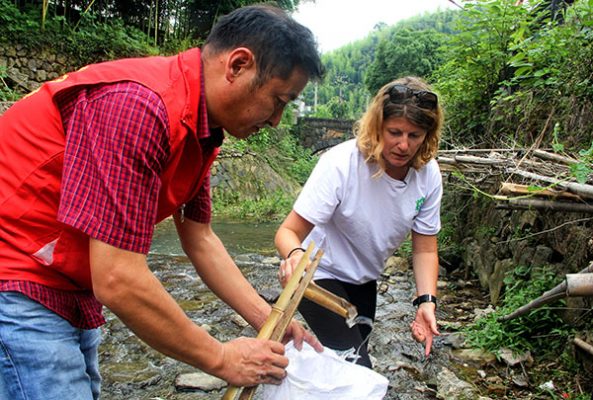Since 2012, the government’s battle against pollution has intensified and more residents have become involved in protection efforts, as Zheng Jinran reports.

In the seven years that she has lived in Houwu, a village in the eastern province of Zhejiang, Tori Widdowson has witnessed many changes in the quality of the local environment.
In 2000, the 43-year-old moved to Houwu from Shanghai, lured by the beautiful scenery, clean air and water that can be drunk directly from mountain springs.
However, those factors have also attracted a growing number of visitors in recent years, resulting in higher levels of garbage, such as a discarded cans and bottles.
Recently adopted measures, such as the installation of more trash cans and signs urging visitors to dispose of rubbish in appointed places have helped alleviate the problem, but Widdowson is also making her own contribution-by becoming a civil “river chief”.
“Whenever I see bottles in the rivers, I pick them out,” said the British national, whose activities have made her popular with the locals.
Moreover, every year, she arranges for students from international schools in Shanghai and Zhejiang to visit and collect discarded bottles and other garbage “to raise the younger generation’s awareness of environmental protection”.
At the start of the year, Widdowson was delighted to be nominated as the village’s civil river chief and she now works alongside official river chiefs-leading local government officials tasked with combating water pollution.
“I am thrilled and want to do much more,” she said.
Coordinated efforts
Since November 2013, Zhejiang has appointed six provincial-level river chiefs, along with 199 at the city level, 2,688 at the county level and 16,417 at the township level to coordinate efforts to improve water quality.
Widdowson’s appointment is one of number of measures adopted by Huzhou city, which administers her village, under which local people assist officials by patrolling riverbanks, reporting pollution and submitting suggestions.
To reduce the volume of waterborne garbage, Widdowson has submitted a suggestion that sea bins-submerged containers that use pumps to trap and filter garbage-should be installed in reservoirs and river mouths.
Three other expats-from Germany, the Philippines and the Netherlands-are also working as civil river chiefs in Huzhou.
Zhang Bo, head of water quality management at the Ministry of Environmental Protection, has confirmed that the measure will be expanded rapidly, and official river chiefs will be appointed in every province, city, county and township in the country by the end of next year.
‘Gold and silver’
When he assumed office in 2012, President Xi Jinping pledged to improve the environment and promote healthier lives for China’s people, saying “clean water and lush mountains are as valuable as gold and silver”.
As a result, the government has adopted a range of measures and encouraged greater public participation in safe-guarding the environment and controlling pollution. That has resulted in fewer cases of severe pollution in rivers and lakes nationwide, according to data released by the ministry.
China’s rapid economic development and growing wealth have enabled the government to tackle the problem more effectively.
“The past five years have seen the adoption of the strongest environmental protection measures ever, along with the toughest implementation and enforcement, the biggest promotion and the best conservation performance,” according to a statement released by the ministry.

Bluer skies
The high number of “blue sky” days in the latter part of the year has allowed Zhang Yajun, a 29-year-old resident of Shijiazhuang, capital of Hebei province, to take more walks with her baby daughter.
“I remember the heavy smog during the winters of 2013 and ’14 that made me cough a lot,” she said, noting that the improvement in air quality has been obvious in the past two years.
Last year, the average concentration of PM2.5-hazardous fine particulate matter that can enter the lungs and blood-stream-in the smog-plagued Beijing-Tianjin-Hebei cluster fell by more than 30 percent from 2013, when the area was shrouded in thick smog.
In August, the average concentration of PM2.5 in Beijing fell to 38 micrograms per cubic meter, a year-on-year decline of more than 19 percent and the lowest level since 2013, according to data from the capital’s environmental protection bureau.
“Control of air pollution has been a top priority in the past five years,” said Liu Bingjiang, head of air quality management at the ministry, who added that air quality will continue to improve in the Beijing-Tianjin-Hebei cluster and neighboring provinces.
“From October (this year) to March 2019, 28 major cities in the northern region will see the concentration of PM2.5 fall by at least 15 percent, while Beijing, Tianjian and Shijiazhuang will see reductions of 25 percent and the number of severely polluted days will fall by 20 percent.”
To facilitate government efforts to reach those targets He Kebin, dean of Tsinghua University’s School of Environment, is currently leading a team of researchers in Hebei province. He’s team is just one of 28 that will head to cities across the region to conduct research into the sources of air pollution.
In addition to a stronger focus on air pollution, the country has also seen reductions in soil and water pollution as a result of greater efforts to limit the number and volume of toxins-such as agricultural chemicals-either being illegally discharged or leaching into the ground, and therefore, rivers, lakes and water tables.
Meanwhile, measures to improve the rural environment in about 100,800 villagers across the country have resulted in better lives for more than 190 million people in the countryside in the past five years, the ministry said.
Green coverage has expanded and the area of desertified land continues to shrink, as a result of afforestation projects designed to prevent soil erosion and reclaim affected land.
Last year, a report by the UN Environment Program, called the Strategy and Actions of China’s Ecological Civilization, offered an explanation of the model and highlighted innovations such as the “ecological redline”, boundaries imposed to prevent construction or other human activities within specified areas aimed at allowing flora and fauna to develop naturally.
In the report, Achim Steiner, executive director of UNEP at the time the report was published, expressed the hope that the world could better understand the strategy and be inspired to promote global action for sustainable development.
Tougher punishments
In the past five years, many existing laws and regulations have been revised to make them more effective, while a host of new legislation has been passed to redouble efforts to prevent pollution.
For example, the revised Environmental Protection Law, which came into force on Jan 1, 2015, gives environmental inspectors greater powers, and ensures that polluters face higher fines and a range of tougher punishments and even jail sentences.
Last year, a record 137,800 cases were filed against people and companies accused of contaminating the environment, according to the Supreme People’s Court.
In addition, by September the central government had launched high-level inspections across every province, autonomous region and municipality.
“By Sept 15, the inspectors had delivered 12,846 pollution reports to provincial and city governments, and 94.5 percent have already been dealt with,” the ministry said.
By the end of August, more than 12,000 government officials nationwide had been held accountable for poor environmental protection performances, it added.
According to Liu Changgen, deputy director of central-level inspections at the ministry, inspection teams will visit 10 cities in the Beijing-Tianjin-Hebei cluster and neighboring provinces by the end of the year.
“The leading officials and governments will conduct stricter monitoring to implement the protection policies and measures,” he said.


